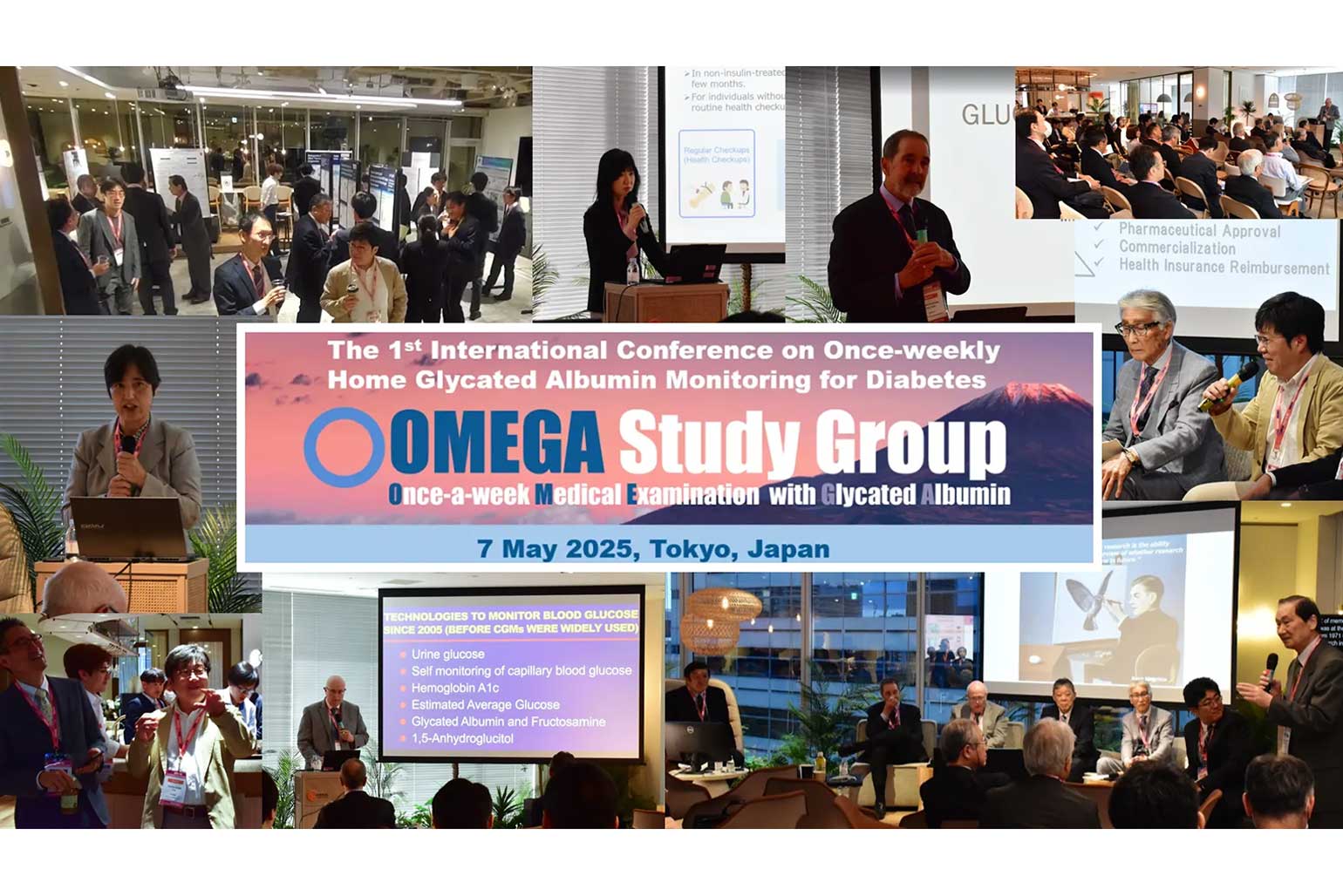
News
Latest information






On May 7, 2025, the “OMEGA Meeting 2025” organized by the OMEGA Study Group was held at Coral Beach in Minato-ku, Tokyo.
This event was designed to facilitate knowledge-sharing among practitioners in the fields of research, healthcare, and public policy, with the goal of promoting the social implementation of home-based monitoring using glycated albumin (GA). GA has recently attracted attention as an early indicator for diabetes management. The OMEGA Study Group has been promoting cross-sector collaboration among academia, industry, and government to advance the research, development, and public awareness of GA.
Event Overview
Event Name: OMEGA Meeting 2025
Date: Wednesday, May 7, 2025
Venue: Coral Beach (Minato-ku, Tokyo)
Organizer: OMEGA Study Group
Format: Hybrid (in-person and online via Zoom)
Main Program
History of Clinical Development of Glycated Albumin
A presentation was given by researchers who played a pivotal role in the standardization and clinical implementation of GA, tracing its development from the 1980s.
Keynote Lectures
The first keynote was delivered by Dr. David Klonoff, a leading expert in diabetes technology, who reviewed the evolution of glucose monitoring—from urine glucose testing, SMBG, HbA1c, GA, fructosamine, 1,5-AG, to CGM—and its impact on diabetes care. He also introduced the “Glycemia Risk Index (GRI),” a new framework for interpreting glucose data.
Dr. William Polonsky, known for his focus on the psychological aspects of diabetes, gave the second keynote. Based on the premise that “no one is unmotivated to live a long and healthy life,” he emphasized five essential elements to enhance patient engagement: frequency of feedback, personal meaningfulness, clarity, guidance and support, and patient characteristics. His lecture highlighted the importance of patient-centered care enabled by technology.
Progress Report on Home-Based GA Monitoring Research
Research findings were shared on how visualizing GA results at home can promote behavioral change. Insights into how these findings are being applied in community settings were also presented.
On-the-Ground Report from Provigate
A nurse from our team presented real-world experiences from our postal GA monitoring pilot program. Specific examples were shared, demonstrating how weekly self-measurement of GA encouraged individuals to become more conscious of blood sugar control and improve their lifestyle habits. Strategies for improving user retention and practical challenges in service delivery were also discussed from a frontline perspective.
Discussion on Policy and Technical Issues
A comprehensive discussion was held on topics such as the future direction of GA technology, standardization, development of evaluation indices, and alignment with the medical reimbursement system. Key considerations for system design in the implementation phase were outlined.
Poster Session
Posters on GA-related research were presented by academia and industry, sparking active discussions throughout the session.
Future Outlook
The OMEGA Study Group will continue to accumulate evidence on the effectiveness of once-weekly GA monitoring and its role in behavioral support. We aim to strengthen collaboration for community-based implementation and policy recommendations. All findings and discussions will be shared continuously to contribute to the broader society.
For more information, please refer to the official websites below:
OMEGA Study Group Official Website: https://omega-study.org/OMEGA-Study-Group-b1a2c2e091ef45c8bc6f3d07353c761a
OMEGA Meeting 2025 Report: https://cuboid-broker-507.notion.site/OMEGA-Meeting-2025-Report-1f890268eccf80f0966cf3d5c46caba9
People may think of glucose monitoring as simple as this: "Diabetes is a disease of blood sugar. This is why people with diabetes use glucometer."
However, it's not that simple. Blood sugar measurement has diverse objectives, including diagnosing diabetes, dosing self-injection of insulin, avoiding hypoglycemia due to excessive drug efficacy, and behavior change.
You must choose the appropriate blood sugar measurement method for your purpose.
There are two types of self-blood glucose measurement methods: SMBG (Self-Monitoring of Blood Glucose), which is widely used, and CGM (Continuous Glucose Monitoring), which has become popular in recent years.
These two blood glucose measurement methods are designed mainly for patients who self-inject insulin and other injectable drugs.
Until now, there has been no simple and daily method for measuring blood glucose at home other than these two methods.
Some drugs, such as insulin, are very potent and can cause dangerous hypoglycemia if the dosage is incorrect.
Therefore, for example, those who use insulin must measure their blood glucose accurately before self-injection at home and carefully determine the dose.
After injection, if there are signs of hypoglycemia, it is necessary to measure blood glucose immediately. If necessary, you need to take some sugar to avoid hypoglycemia.
However, both methods have an issue with invasiveness. In addition, they cost a lot. CGM costs at least $60 and needs to be replaced every two weeks, which is also a significant economic burden. SMBG requires frequent measurements, so the total cost becomes significant when accumulated.
Unfortunately, SMBG and CGM are not suitable for everyone due to invasiveness and cost.
At Provigate, we are looking for individuals who genuinely care about each user, are passionate about supporting health, and want to work together to create a new future for healthcare and medicine.
If you’re someone who wants to leverage your experience as a healthcare professional, enjoys the fusion of technology and medicine, and is eager to take on new challenges, we’d love for you to join us!
Copyright© Provigate, Inc. All Rights Reserved.